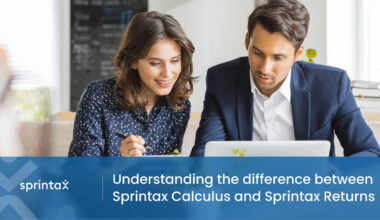At the recent Nonresident Tax Clinic, our panel of industry thought leaders explored the world of tax compliance and outlined the latest developments in rules and regulations for taxation of nonresidents in the US.
This fascinating event was ideal for anyone working within a HR, payroll department, or international office and who is interested in learning more about nonresident tax compliance.
If you missed the Nonresident Tax Clinic and would like to check it out, you can watch it back here.
On the day, a fantastic line-up of speakers took part in the event including Jim Webb, Nonresident Tax Specialist, University of Missouri – St Louis, Will Drath, Nonresident Tax Specialist, University of Missouri – Columbia and Ryan Ludden, Associate Vice President, Sprintax.
There were a number of key takeaways from the event and we are going to discuss five of the most important learnings here.
In the meantime, if you would like to learn how Sprintax Calculus can support your organization with US nonresident tax withholding solutions, why not reach out to our team today?
1 – The three pillars of nonresident tax determination
There are three pillars to keep in mind when navigating the world of nonresident tax compliance. Always think RTS…
R – Residency of income recipient (for tax purposes)
T – Type of income
S – Source of income
By taking each of these three pillars into account, we can better understand how each nonresident within an organization should be taxed and whether or not there are US tax implications on payments being made to them.
Residency for tax purposes
The first step is to determine whether an individual is considered a resident or nonresident for tax purposes.
A foreign national may be considered a resident for tax purposes if they either pass the Substantial Presence Test or possess a Green Card.
F, J, M or Q visa holders are typically considered nonresidents for tax purposes. What’s more, international students on J1 & F1 visas will automatically be considered nonresidents for tax purposes for the first five calendar years of their time in the US.
Meanwhile, interns/trainees, Teachers, W & T, Camp Counselors, Scholars/Researchers, Physicians (and their dependents) on J visas are considered nonresidents for tax purposes for two out of the last six calendar years preceding the current year in the US.
We have discussed the importance of tax residency and the Substantial Presence Test in greater detail here.
Type of income
What type of income is the individual receiving – for example, is it employment, scholarship, or royalties? The amount of tax withheld will largely depend on the specific type of income in question.
Source of income
How the source of an individual’s income is defined will play an important role in how that income will be taxed.
A nonresident alien is usually subject to US income tax on ‘US-sourced’ income only.
The IRS uses the below table to determine whether or not income is considered to be US sourced.
Income type Source is determined by
Salaries, wages, other compensation Where services performed
Scholarships – Fellowships Generally, the residence of the payer
Royalties Where property is used
Interest Residence of payer
Dividends Where payer is incorporated
Rents Location of property
Sale of real property Location of property
Sale of personal property Seller's tax home
Pensions Where services were performed that earned the pension
Sale of natural resources Allocation based on the fair market value of the product at export terminal
Business income (personal services) Where services performed
Business income (sale of inventory – purchased) Where sold
Business income (sale of inventory – produced Where produced (allocation may be necessary)
Let’s take a look at an example.
A French citizen, Martin is working as a nonresident lecturer at a US university. While lecturing on US soil, it is straightforward to understand that this will be US sourced income.
Should Martin return to France and continue to perform lecturing services at the same university, this income will no longer be considered as US sourced.
If you would like to learn more about how to determine income source, check out our whitepaper on the topic here.
Tip from our panel
“Income sourcing rules can be really tricky,” says Will Drath, Nonresident Tax Specialist, University of Missouri – Columbia.
“Perhaps as a result of the pandemic, it has become a common scenario for a nonresident employee to work abroad and their income can potentially become foreign sourced. Many employers are still unaware of these rules but it is very important to come to terms with them. Without this, it can be very challenging to withhold tax correctly.”
2 – How are nonresidents taxed in the US?
Federal income tax
The IRS requires federal income tax withholding on all US source payments to nonresident aliens.
Tax rates withheld in the US are graduated from 10% – 37% and most nonresidents pay tax from the first dollar.
Tax deductions for nonresidents
Most nonresidents are not entitled to use the standard deduction to reduce their income tax liability (Indian students, trainees and business apprentices may be entitled to do so). What’s more, with the personal exemption being reduced to $0, most nonresidents will be taxed from the first dollar earned.
The good news for many nonresidents is that they can potentially reduce their tax liability by claiming tax treaty benefits. More information below.
In limited cases, child credits can be used by eligible nonresidents for a qualifying child. These include Canadian, Mexican, South Korean and Indian students, trainees and business apprentices.
Tip from our panel
“It’s also important to remember that, if an employee fails to provide the necessary paperwork or their Social Security Number (SSN) when they start work, an employer has the right to apply the backup withholding amount of 30%,” says Ryan Ludden, Associate Vice President, Sprintax.
“I would also flag one of the biggest mistakes or errors that occur when somebody is hiring a foreign national and that is generally when it comes to applying the standard deduction. Most nonresidents cannot use the standard deduction, although Indian students, trainees and business apprentices can avail of it.”
Tax on scholarship income
How this income is taxed depends on whether it is considered ‘qualified’ or ‘non-qualified’.
Qualified scholarship is not reportable and not taxable. This includes income paid to a degree candidate as a scholarship or fellowship grant where the amount covers:
- Tuition and fees required for enrollment or attendance at an educational organization
- Fees, books, supplies, and equipment required for courses of instruction at the educational organization
Meanwhile non-qualified scholarship is generally reportable and taxable.
This is income that a student may receive which is above the cost of required tuition, fees, books, supplies and equipment. Examples of non-qualified scholarships include room and board, travel and stipend.
It is also important to note the differences between a compensatory scholarship and a non-compensatory scholarship.
A compensatory scholarship is generally a scholarship or grant given to students, trainees or researchers. It requires the performance of personal services as a necessary condition for distributing that scholarship. For example, if an individual is a teaching assistant and is performing that service in order to receive their housing allowance or their room and board – this will likely be considered as compensation for personal services or wages by the IRS.
Tax rates on non-employment income
The standard nonresident tax rate for non-employment income is generally 30%. This tax rate is applied to many common types of income including prizes, awards, royalties and dividends.
A reduced rate of 14% can apply to degree candidates on F, J, M and Q visas with regards to scholarship income.
The reduced rate can also apply if the grant is for study, training, or research in the US and paid by:
- A tax-exempt organization operated for charitable, religious, educational, etc. purposes
- A foreign government
- A federal, state, or local government agency, or
- An international organization, or a binational or multinational educational or cultural organization created or continued by the Mutual Educational and Cultural Exchange Act of 1961 (known as the Fulbright-Hays Act)
3 – Who can claim tax treaty benefits?
The US has signed income tax treaties with 67 foreign countries.
These agreements exempt certain income from tax withholding or reduce the amount of tax due.
Implementing tax treaty benefits can be complex for employers. This is especially true for employers that do not have much experience in paying nonresidents.
After all, not every nonresident will be entitled to tax treaty benefits. Whether or not an individual can avail of them will depend on a wide range of factors including:
- Immigration status
- Tax residency of foreign person
- Income type
- The type of payer and tax residency of payer
What’s more, some treaties include additional clauses which must be adhered to. For example, under the Indian tax treaty for teachers and researchers, where an individual who is availing of this benefit stays in the US for more than 2 years, they are required to pay tax on the full period they were originally exempt from tax.
The below table illustrates the impact that a tax treaty benefit can have on a nonresident’s income.
India China Germany Canada France
Visa Type F1 Student F1 Student J1 Intern J1 Lecturer/
ProfessorJ1 Research/
Scholar
Wages $30,000 $30,000 $30,000 $30,000 $30,000
US Tax Residency Nonresident Nonresident Nonresident Nonresident Nonresident
Income Type Income Code 20 Income Code 20 Income Code 20 Income Code 19 Income Code 19
Treaty available Can use standard deductions of $12,950
(2022 TY)$5,000 $9,000 Up to $10,000 (personal services only) No limit
Tax treaty article 21(2) 20(c) 20(4) XV(2)(a) 20(1)
Documents required W4 8233 form 8233 form 8233 form 8233 form
Taxable Wages $17,450 $25,000 $21,000 $30,000 unless they earn less than $10,000 $0
Learn more about tax treaty benefits here.
Tip from our panel
“The most important thing to remember about tax treaties is that, while they may look similar, they’re all different,” says Webb. “There are little nuances to each one of them and you have to make sure that you understand that before you implement a treaty exemption. It’s important to read and understand the treaty document in full before a benefit is provided to a nonresident.”
“It’s just bad news to make an error with treaty benefits,” adds Drath. “It’s so important to be very careful and make sure all of your information is correct before you implement a tax treaty benefit because it can hurt both the employer and the employee if a mistake is made.”
4 – Who is exempt from FICA taxes?
Many nonresidents in the US are exempt from FICA tax withholding, but some are not.
With that in mind, it is easy to see how managing FICA withholding can be challenging for any US organization.
There are, however, a couple of golden rules to follow.
Generally speaking most nonresidents for tax purposes on a J1 and F1 visa are exempt from paying FICA taxes. The IRS considers them to be in the US temporarily (for example, to study before returning to their home country) and are unlikely to ever see the benefit of paying into the FICA scheme.
However, those in the US on F2, J2 and H-1B visas will generally be required to pay FICA tax from the first day of their employment.
There are some important deductions to keep in mind too.
Through the Student FICA Tax Exemption, full-time students who work on campus or work in a field related to their study and who are residents may still be exempt from FICA taxes.
What’s more, 30 countries also have an agreement to exempt an individual from FICA taxes even if they’re residents or nonexempt visa holders, where usually this will require them to provide a certificate of coverage from their home country equivalent of the social security office to their withholding agent in the US e.g. H1B visa holders from France.
What effect does FICA, withheld in error, have on nonresidents?
The below table illustrates just how big a financial impact incorrectly withheld FICA can have on nonresidents.
Visa Type F1 Student J1 Student J1 Intern J1 Researcher
Wages $20,000 $30,000 $40,000 $50,000
US Tax Residency Nonresident Nonresident Nonresident Nonresident
FICA Taxes withheld in error Yes Yes Yes Yes
FICA Tax % 6.2% Social security + 1.45% Medicare tax 6.2% Social security + 1.45% Medicare tax 6.2% Social security + 1.45% Medicare tax 6.2% Social security + 1.45% Medicare tax
NRA employee portion of FICA taxes that could be withheld $1,530 $2,295 $3,060 $3,825
Employer’s part withheld in error $1,530 $2,295 $3,060 $3,825
In order to fix FICA tax withheld in error an employer must amend a quarterly or annual tax return or Form 941. Alternatively, the individual can claim their FICA back directly from the IRS.
Tip from our panel
“It can be challenging for any organization in the US to manage FICA withholding,” says Drath.
“If you haven’t had time to conduct a full tax assessment on an individual – including determining their residency – it can be a good idea to withhold social security and Medicare from their wages, at least initially. Ultimately, it’s usually a lot easier to refund tax to an employee than to try to collect it from them later on. Refunding FICA which was withheld in error is straightforward to do – especially if you do so in the same calendar year.”
5 – Common nonresident tax scenarios
As we can see, every nonresident in the US has a unique tax profile and no two individuals should be treated the same for tax purposes.
Below we take a look at some common scenarios which organizations are tackling on a daily basis.
Scenario 1 – an F1 research assistant
Chen arrived from China on her F1 student visa for the first time in the US in 2019 and started her on-campus employment as a research assistant at a University in 2022. As per the requirements of her visa, she is granted permission to work and she has already received her SSN.
How should Chen be taxed in 2022?
Identification: The university payroll team has reviewed Chen’s I-9 and immigration documents and identified that she is a non-US citizen and needs further processing from a tax perspective.
Residency: Chen is considered a nonresident for tax purposes, as she is still in her 4th year on F1 Visa status.
Income type: Chen is working on campus as a research assistant. Wages paid to her are considered compensation during studying and training.
Tax Treaty Determination: The first $5,000 in compensation she earns is tax free (this is for compensation during studying and training in her first 5 years of their study as long as she is compliant within the requirements of their visa).
Tax Forms: Chen must provide Form 8233 for the income which is exempt under the Chinese tax treaty and the W-4, labeled NRA, for any non-exempt income. The income covered by the tax treaty is taxed at 0%. All other income is taxed at the graduate rate for federal tax purposes.
Result: At the end of the year Chen should receive two income tax documents – Form 1042-S with the income covered by a tax treaty and Form W-2, if she has income over the tax treaty. As a nonresident she is exempt from paying FICA and FUTA taxes.
Scenario 2 – a J1 Physician
Antoine arrived from France on his J1 Physician visa for the first time in 2022. He started his work at the University of Arkansas Medical Institute in 2022 to perform medical research. As per the requirements of his visa, he is granted permission to work, and he has already received his SSN.
How should Antoine be taxed in 2022?
Identification: The payroll team at the University of Arkansas Medical Institute has identified from a review of Antoine’s I-9 and immigration documents that Antoine is a non-US citizen, and needs further processing from a tax perspective.
Residency: Antoine is considered a nonresident for tax purposes, as he is still in his first year on J1 Physician Visa status.
Income Type: Antoine is performing medical research at the University of Arkansas Medical Institute as part of their physician program. Wages paid to him are considered compensation for teaching and research.
Tax Treaty Determination: Antoine can exempt all their income from performing research from tax for the first 24 months, as long as Antoine is compliant within the requirements of their visa.
Tax Forms: Antoine must provide Form 8233 for the income which is exempt under the France tax treaty and the W-4, labeled NRA, for any income which is not paid for research. The income covered by the tax treaty is taxed at 0% and all other income is taxed at the graduate rate for federal tax purposes.
Result: At the end of the year, Antoine should receive Form 1042-S with the income covered by the tax treaty and Form W-2, only if he has personal services income that is not covered by the treaty. As a nonresident he is exempt from paying FICA and FUTA taxes.
Scenario 3 – a J1 Trainee
Advik arrived from India on his J1 Trainee visa for the first time in the US in 2022 and started his training program in 2022. As per the requirements of his visa, he is granted permission to work and he has already received his SSN.
How should Advik be taxed in 2022?
Identification: His employer’s payroll team reviews his I-9 and immigration documents and identifies that Advik is a non-US citizen and needs further processing from a tax perspective.
Residency: Advik is considered a nonresident for tax purposes, as he is still in his 1st year on J1 Trainee Visa status.
Income Type: Advik is training as a researcher. Wages paid to him are considered compensation during studying and training.
Tax Treaty Determination: Advik can use the standard deduction of $12,950 and resident tax credits where applicable.
Tax Forms: Advik does not need to provide an 8233 for the income that is exempt under the Indian tax treaty. However, the W-4 will need to be completed in the same manner as that of a resident for tax purposes with the same exemptions and allowances. Indian students or apprentices are allowed to use the standard deduction as well as child and other dependent tax credits where applicable (provided they meet certain requirements).
Result: At the end of the year, Advik should receive Form W-2. The standard deduction allowance is applied in the calculation of income tax – just as it would be for a tax resident as it is a condition of the Indian tax treaty. As a nonresident, he is exempt from paying FICA and FUTA taxes.
Connect with Sprintax Calculus
Every year, more than 1 million people travel to the US to study and work temporarily.
Sprintax Calculus has been designed specifically to help employers to manage the tax profiles of their nonresident employees all-in-one place, through a user-friendly dashboard.
We have developed an easy-to-use, online software that simplifies residency determination, tax treaty eligibility and nonresident tax withholding for US corporations, educational institutions and not for-profit organizations.
If you would like to learn more about how Sprintax Calculus can support your organization, our team would be happy to discuss our tax solution with you.
Book a demo with our team here








